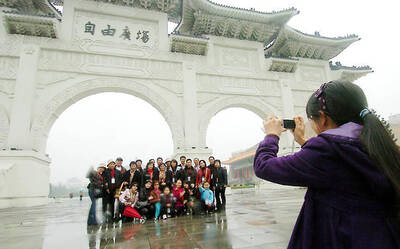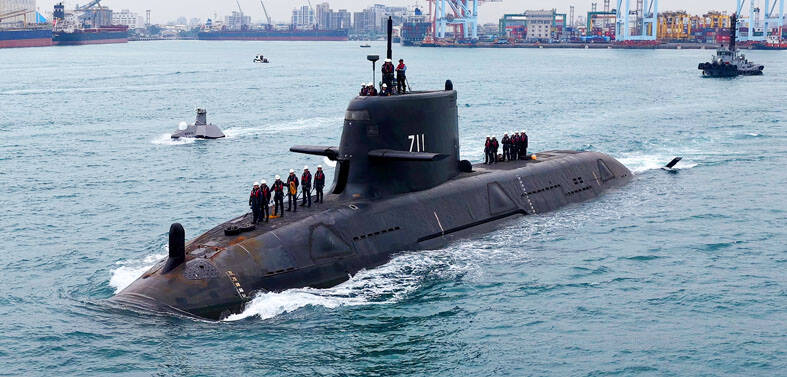Taiwan’s military could deploy surface-to-surface missiles on the Penghu Islands as part of efforts to mount a more credible deterrent capability against China, budgetary documents submitted earlier this month say.
According to the documents, the Ministry of National Defense’s Missile Command would deploy three missile squadrons at a fixed base on Penghu as part of a NT$2.5 billion (US$84.8 million) “Ji Zhun” (戟隼) plan for the acquisition of Hsiung Feng IIE (HF-2E) land attack cruise missiles. Part of the budget would reportedly be set aside for the construction of bunkers with dehumidifying systems to store the missiles.
President Ma Ying-jeou (馬英九) in 2008 gave the go-ahead for the production of 300 HF-2Es. The missile, developed by the Chung-Shan Institute of Science and Technology, was approved for full production earlier this year.

Photo: Military News Agency via CNA
The HF-2E can be fired from land-based emplacements as well as surface vessels. With an estimated range of 600km, the HF-2E brings some ports in southern China within range, which would now be extended by being deployed on Penghu, located in the middle of the Taiwan Strait.
HF-2Es have been spotted on naval vessels anchored at Penghu’s Makung (馬公) and Tien Kung II surface-to-air missiles are deployed there.
Stating standard procedure on military deployments, a Ministry of National Defense spokesman yesterday would not comment on the report, which first appeared in the Chinese-language United Daily News on Wednesday last week.
The amount of money to be spent on indigenous defense programs next year is the highest since 2000, reflecting growing fears within the military of a possible scaling back of arms sales to Taiwan by the US.
According to a Defense News article on Monday, new development programs could include an anti-radiation unmanned aerial vehicle (UAV), a graphite bomb, an electromagnetic pulse weapon, a hypersonic vehicle testing capability, a long-range UAV, ship stealth technology and a catamaran-hulled ship.
A US-based defense analyst told the Taipei Times that insecurity stemming from perceived diminishing US support could spark Taiwan to adopt “more radical solutions,” such as the deployment of offensive missiles like the HF-2E.
“Given China’s increasingly formidable air defenses, using fixed wing air assets, such as F-5s or F-16s, to strike mainland targets has become increasingly costly. Therefore, investments in systems, such as the HF-2E, could be viewed as necessary to maintain a limited retaliation capability,” the analyst said.
US policy has long denied Taiwan efforts to acquire air-launched weapons considered offensive, such as Joint Direct Attack Munitions and AGM-88 High-speed Anti-Radiation Missiles. The US Department of State has also repeatedly blocked, under the Missile Technology Control Regime (MTCR), attempts by Taiwan to acquire components that would help it extend the range and yield of its missiles.
“The State Department is the keeper of the MTCR and ‘defensive weapons’ flame of the Taiwan Relations Act,” Rick Fisher, a senior fellow on Asian military affairs at the Washington-based International Assessment and Strategy Center, told the Taipei Times last week. “Absent a White House level of policy change, the US is not going to offer any leadership in this direction.”
The first analyst said there seemed to be some inconsistencies in Washington’s strict adherence to the MTCR when it comes to Taiwan.
“I don’t see much complaining about China developing and fielding missile systems able to strike targets on Taiwan and throughout the region,” he said.

US climber Alex Honnold is to attempt to scale Taipei 101 without a rope and harness in a live Netflix special on Jan. 24, the streaming platform announced on Wednesday. Accounting for the time difference, the two-hour broadcast of Honnold’s climb, called Skyscraper Live, is to air on Jan. 23 in the US, Netflix said in a statement. Honnold, 40, was the first person ever to free solo climb the 900m El Capitan rock formation in Yosemite National Park — a feat that was recorded and later made into the 2018 documentary film Free Solo. Netflix previewed Skyscraper Live in October, after videos

NUMBERS IMBALANCE: More than 4 million Taiwanese have visited China this year, while only about half a million Chinese have visited here Beijing has yet to respond to Taiwan’s requests for negotiation over matters related to the recovery of cross-strait tourism, the Tourism Administration said yesterday. Taiwan’s tourism authority issued the statement after Chinese-language daily the China Times reported yesterday that the government’s policy of banning group tours to China does not stop Taiwanese from visiting the country. As of October, more than 4.2 million had traveled to China this year, exceeding last year. Beijing estimated the number of Taiwanese tourists in China could reach 4.5 million this year. By contrast, only 500,000 Chinese tourists are expected in Taiwan, the report said. The report

Temperatures are forecast to drop steadily as a continental cold air mass moves across Taiwan, with some areas also likely to see heavy rainfall, the Central Weather Administration (CWA) said. From today through early tomorrow, a cold air mass would keep temperatures low across central and northern Taiwan, and the eastern half of Taiwan proper, with isolated brief showers forecast along Keelung’s north coast, Taipei and New Taipei City’s mountainous areas and eastern Taiwan, it said. Lows of 11°C to 15°C are forecast in central and northern Taiwan, Yilan County, and the outlying Kinmen and Lienchiang (Matsu) counties, and 14°C to 17°C

STEERING FAILURE: The first boat of its class is experiencing teething issues as it readies for acceptance by the navy, according to a recent story about rudder failure The Hai Kun (海鯤), the nation’s first locally built submarine, allegedly suffered a total failure of stern hydraulic systems during the second round of sea acceptance trials on June 26, and sailors were forced to manually operate the X-rudder to turn the submarine and return to port, news Web site Mirror Daily reported yesterday. The report said that tugboats following the Hai Kun assisted the submarine in avoiding collisions with other ships due to the X-rudder malfunctioning. At the time of the report, the submarine had completed its trials and was scheduled to begin diving and surfacing tests in shallow areas. The X-rudder,